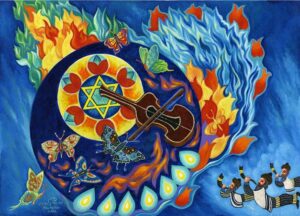בס”ד
By Rabbi Moshe Goodman, Kollel Ohr Shlomo, Hebron

This parsha emphasizes the census of Israel which comes out to the number of six hundred thousand approximately. Indeed, the Kabbalists tie this number six with the six days of Creation. With that there is also a seventh aspect, just like Shabbat, the holy day, is the seventh day. This seventh aspect correlates with the Levites, enumerated separately, who deal with the the holy internal service. These ideas can be depicted in the Star of David which has six points/hollow spaces within them, but yet also has an internal hollow space in the middle, corresponding to the seventh aspect. Indeed, we see a violin protruding into the center of of the Star of David, apparently hinting to King David’s playing of a musical instrument called a “kinor,” and today a violin is called a”kinor” [even the Biblical “kinor” was very different than the modern violin, nevertheless an association may be made].
In this painting we see the Star of David as a central image, and other aspects of seven as well. For example we see seven lights, clearly corresponding to the seven lights of the Menora. We also see seven butterflies which may also represent the process of metamorphosis from a caterpillar to a butterfly. Metamorphosis of seven aspects carries a deep connection to the Kabbalistic idea called the “breaking and renewal of the seven vessels.” This idea entails that after a process called “the breaking of vessels” there was a process of a renewal of these vessels through a type of spiritual “gestation”, causing these vessels to be renewed with new spiritual “lights” that resembles a type of “metamorphosis.” [Interesting to note that in modern Hebrew butterfly is parpar, a word that resembles the Kabbalistic concept of “par dinim”=280 aspects of judgment, and judgment is Kabbalistically associated to flames of fire seen in this painting, and also these “par dinim” are also Kabbalistically associated to the renewal/”metamorphosis” we just discussed.]
To the right bottom we see three figures sounding the shofar, a matter that may hint to the influence of the three upper sefirot upon the seven lower sefirot indicated by the various seven elements we just discussed. This idea is supported by the fact that the human, especially en-wrapped in a talis, as seen in the painting, represents the more Divine level. Also sounding the shofar may represent the day of Rosh Hashana when man was created, who himself was in a sense “blown into” by Hashem, and by such was given his Divine soul. Indeed, the three upper sefirot are considered more Divine aspects than the seven lower more “earthly” sefirot that receive from them.
Hebron is a symbol of unity – hibur – to our People, carrying the common roots of our People, “the three Divine Patriarchs,” and shining the light of our common Holy Land, Land of the Divine Presence. Thus, just as the six-hundred thousand are united around the Mishkan, place of the Divine Presence, so too Israel are united through the Divine light of Hebron and the three Patriarchs!



